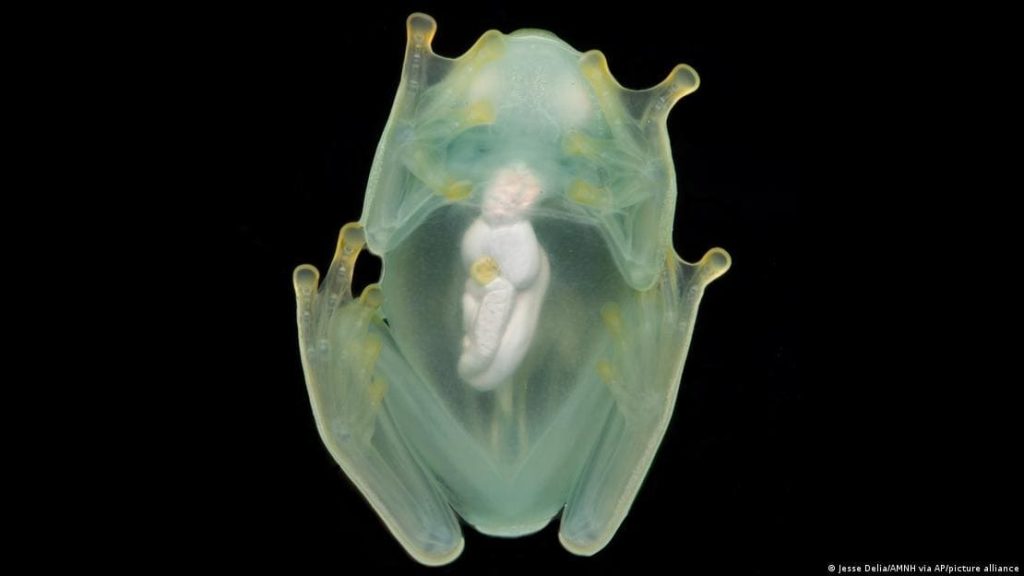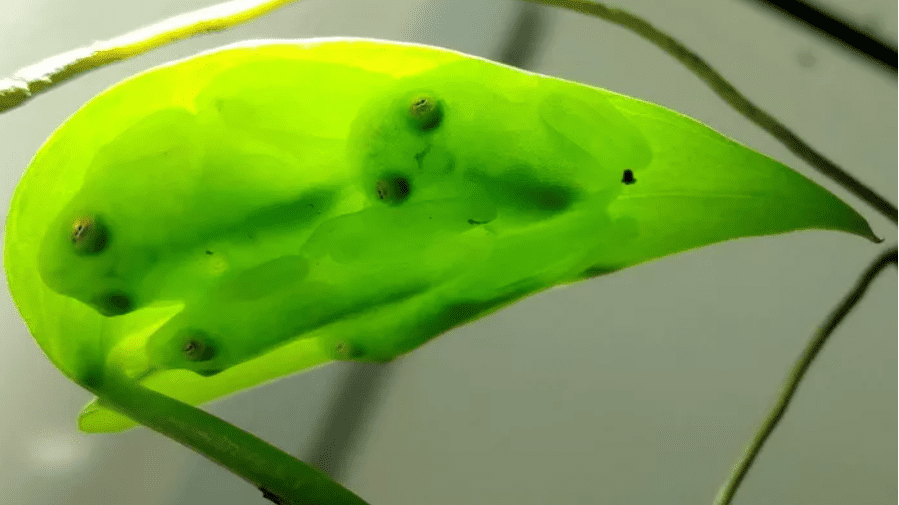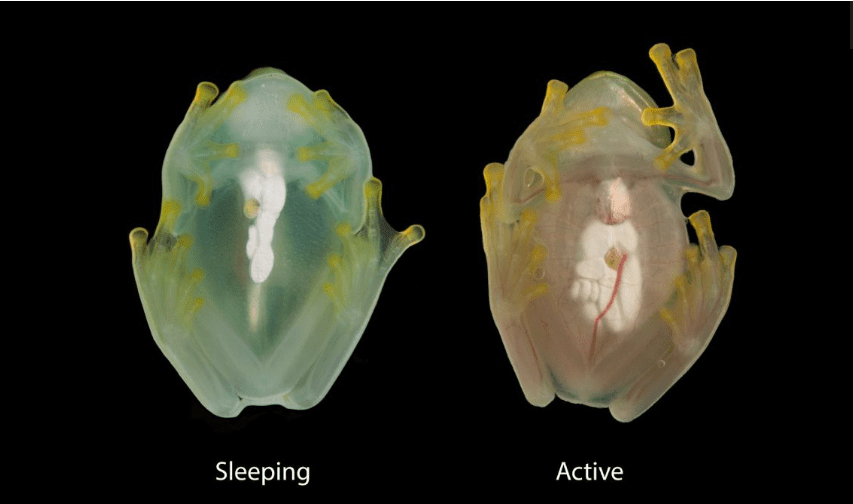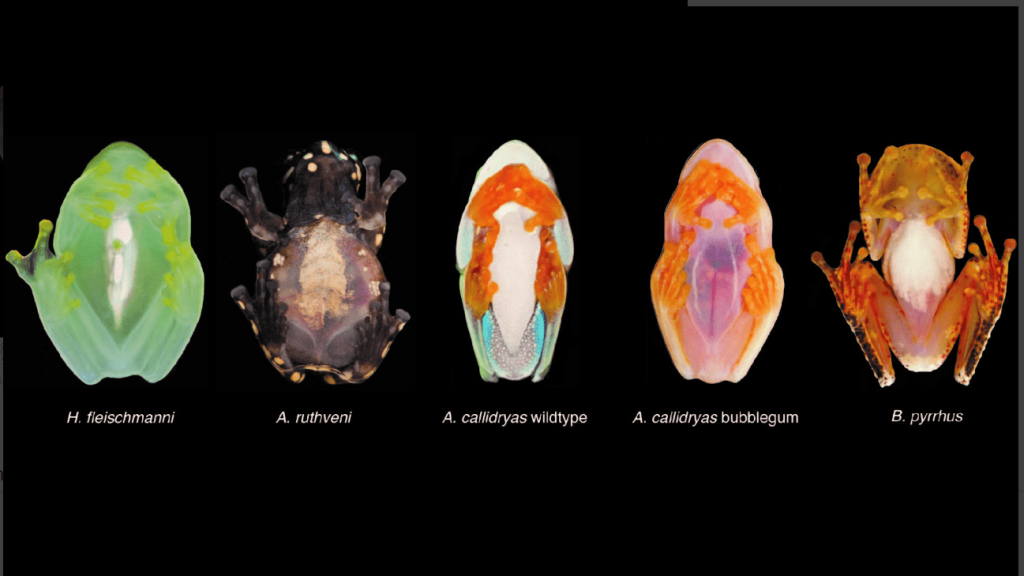Glass frogs can render themselves nearly invisible while they sleep with a unique trick; they pack nearly 90% of their red blood into one of their organs. This increased transparency appeared to be related to a decrease in the number of red blood cells coursing through their veins.

Glass frogs are one of the unique species native to the forests of Central and South America and get their name from their translucent skin and muscles that blend in with their jungle surroundings. When you turn these animals upside down, thier hearts, livers, and squiggly coils of intestines are. There is a study published in the journal Science reveals that the northern glass frog (Hyalinobatrachium fleischmanni) pulls off this feat by removing almost 90% of its red blood cells from circulation and packing them into its liver. The findings reveal how one of the only transparent land animals hides its blood.

When a glass frog falls asleep, it vanishes. The frog’s bright green back blends in and the underbelly’s reddish hue quickly grows transparent. Acording to study co-author Sönke Johnsen who is a professor of biology at Duke University in North Carolina, told Live Science that “These glass frogs are — by some process; we don’t know the details — filtering red blood cells out of their blood and cramming them into their livers so tightly that it should create a clot. But it doesn’t.”
Understanding why these clots never form could have implications for human diseases, the researchers said.

Northern glass frogs seldom grow larger than 1 inch (2.54 centimeters) in length and spend most of their adulthood perched on leaves in Central and South American forest canopies, high above the rapidly flowing streams where they lay their eggs. Their underbellies are translucent even when the frogs are awake, allowing an observer to easily see their hearts pumping red blood throughout their bodies. But scientists have long been fascinated by the way the frogs’ bellies turn transparent when they fall asleep, rendering them all but invisible to predators.
To better understand this phenomenon, Johnsen and colleagues tracked the red blood cells circulating throughout glass frogs’ bodies. One of these methods, known as photoacoustic microscopy, is not unlike ringing a bell with a laser beam — scientists shine a bright light onto the frog’s body and capture the sound waves produced whenever the light strikes hemoglobin, the protein in red blood cells that carries oxygen and gives blood its distinctive color.

“Even with a transparent animal, seeing exactly what is going on inside can be difficult,” Johnsen said. “We used sound because it travels through tissue much better than light.”
Once they had developed this technique, studying how glass frogs turn transparent was a simple matter of repeatedly agitating the hapless amphibians. “We’d let the frog rest, then poke it a few times, and let it fall asleep again,” Johnsen said. Following the hemoglobin revealed that glass frogs pull 89% of their red blood cells from circulation and stash them in their livers. Since their skin reflects very little light and their blood, sans hemoglobin, does not absorb it, they become almost entirely transparent.
Johnsen and colleagues hope that further study of this phenomenon will shed light on human clotting disorders and inform research into anticoagulants.”The human body is always at this sharp edge between clotting too little and too much, whether we’re talking about the big clots in strokes, which cause terrible damage, or little micro-clots at the periphery, which cause so much misery,” Johnsen said. “The clotting process for frogs is not so different from that of humans, so whatever we learn from the frogs could end up being relevant to human clotting.”

But so much about this process, including how they survive with so little hemoglobin circulating while they sleep, remains unclear. So before glass frogs can inform clinical research, Johnsen and colleagues will need to figure out just how the amphibians are manipulating their blood.

“What these frogs are doing is the equivalent of a human taking all their blood and stuffing it into a lunch bag inside their body,” Johnsen said. “How are glass frogs doing that? The cool thing is that we just don’t know.”
Source: Live Science






